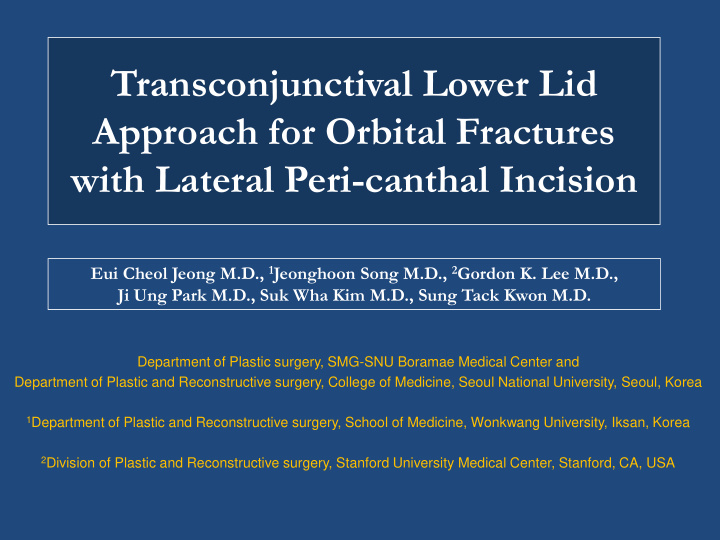



Transconjunctival Lower Lid Approach for Orbital Fractures with Lateral Peri-canthal Incision Eui Cheol Jeong M.D., 1 Jeonghoon Song M.D., 2 Gordon K. Lee M.D., Ji Ung Park M.D., Suk Wha Kim M.D., Sung Tack Kwon M.D. Department of Plastic surgery, SMG-SNU Boramae Medical Center and Department of Plastic and Reconstructive surgery, College of Medicine, Seoul National University, Seoul, Korea 1 Department of Plastic and Reconstructive surgery, School of Medicine, Wonkwang University, Iksan, Korea 2 Division of Plastic and Reconstructive surgery, Stanford University Medical Center, Stanford, CA, USA
Disclosure • No financial disclosures.
Objective of the study • The transconjunctival approach with lateral canthotomy is popular approach in orbital fractures because of minimal external scar. • if the lateral canthotomy area is improperly repaired, it may cause lower lid malposition and deformity.
• The authors report the use of a modified transconjunctival incision method to overcome possibility of improper repair in cantholysis.
Material and Method • Between January 2011 and December 2012, this technique was used in 30 patients with orbital fractures. • We performed lateral cantholysis by lateral peri-canthal incision
Operation method Supported by the handle of • The incision is designed a empty scalpel holder line is drawn perpendicularly to the gray line, past the eyelashes approximately 3 mm away from gray line • The design is extended obliquely in the inferolateral direction, along minor skin crease, for 5 - 8 mm.
The additional transconjuctival incision is extended medially towards the punctum along the inferior margin • The incision is of the tarsal plate made through the skin and full thickness of the eyelid, including the tarsal plate .
The inferior orbital rim and floor are • The lower lid can accessed by dissecting through the usual submuscular plane readily be distracted, or "swung", away from the globe without the need for excessive tension .
• With satisfactory repair of orbital fracture(s), the incision is closed by the meticulous apposition of the divided structures.
• Most notably, the tarsal plate and gray line are used as focal loci of approximation to restore the anatomy of the lower eyelid.
• The tarsal plate is repaired with an inverted 6-0 vicryl suture with the knot buried. The conjunctiva is closed with 7-0 vicryl, and skin with 6-0 silk
Result • One re-operation was required in a case of preseptal hematoma. • One patient presented with notch deformity but did not feel the need for a revisional operation. • 29 patients were satisfied with the aesthetic and functional outcome
Case Blow out fracture of right orbit floor in 46 yr old man Preoperative Photo (Initial visit) Postoperative Photo (1yr follow-up)
Conclusions • In the modified transconjunctival incision with lateral peri-canthal incision, provides excellent exposure of the orbital floor. • The aesthetic and functional outcomes of the eyelid aperture were excellent
Significance of the findings • The decoupling of lower eyelid through the lateral portion of tarsal plate provides a reliable and consistent landmark by which the anatomy of eyelid could again be restored in the transconjuctival approach for orbital fractures
Recommend
More recommend